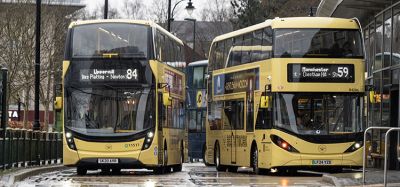Major advances in eTicketing
- Like
- Digg
- Del
- Tumblr
- VKontakte
- Buffer
- Love This
- Odnoklassniki
- Meneame
- Blogger
- Amazon
- Yahoo Mail
- Gmail
- AOL
- Newsvine
- HackerNews
- Evernote
- MySpace
- Mail.ru
- Viadeo
- Line
- Comments
- Yummly
- SMS
- Viber
- Telegram
- Subscribe
- Skype
- Facebook Messenger
- Kakao
- LiveJournal
- Yammer
- Edgar
- Fintel
- Mix
- Instapaper
- Copy Link
Posted: 6 December 2005 | ET | No comments yet
KreisVerkehr Schwäbisch Hall ready to pioneer a trailblazing system.
The Kreisverkehr utility in the district of Schwäbisch Hall covers an area of approx. 190,000 inhabitants and a transport network more than 4,000 km in length.With a total of 1000 stations and train stops, the transport utilities deliver a transport performance of 116,000 person-kilometres and more than 15 million passenger trips per annum.
KreisVerkehr Schwäbisch Hall ready to pioneer a trailblazing system. The Kreisverkehr utility in the district of Schwäbisch Hall covers an area of approx. 190,000 inhabitants and a transport network more than 4,000 km in length.With a total of 1000 stations and train stops, the transport utilities deliver a transport performance of 116,000 person-kilometres and more than 15 million passenger trips per annum.
KreisVerkehr Schwäbisch Hall ready to pioneer a trailblazing system.
The Kreisverkehr utility in the district of Schwäbisch Hall covers an area of approx. 190,000 inhabitants and a transport network more than 4,000 km in length.With a total of 1000 stations and train stops, the transport utilities deliver a transport performance of 116,000 person-kilometres and more than 15 million passenger trips per annum.
The use of chip cards as a customer medium is no novelty in Schwäbisch Hall. The ’RegioCard‘ is already being used to pay for tickets throughout the transport system. However, the range of options available to customers in using this medium is to be greatly expanded in the transport system area of Kreisverkehr Schwäbisch Hall, reducing the currently protracted transaction times required by the payment process at the same time. The introduction of a contactless electronic ticketing system is to make a decisive contribution to securing and improving the earnings situation of the public transport system in this rural area. In addition, the ‘City Card’ Schwäbisch Hall, a contactless chip card based on the Mifare technology is to be integrated, featuring a bonus and discount system. This card is issued by the public utility Schwäbisch Hall GmbH and is already being used very successfully for parking and as an entry card to public swimming pools. Other special offers in the retail trade and for special events are to follow.
In order to take account of changing age structures, new customer groups and potentials will need to be developed. Transport utilities are focusing on occasional travellers in particular. In order to reduce the frequently cited reluctance of this customer group in particular, customers are granted cashless payment facilities when using public transport after signing up. For the customers’ convenience, travel costs are charged to their specified accounts by direct debit.Apart from occasional users, the distribution concept of Schwäbisch Hall focuses in particular on BahnCard (German Rail) holders. The existing chip card solution offered by the public utility Schwäbisch Hall, the BahnCards of DB AG customers and the mobility card in Baden-Wurttemberg are therefore planned to be integrated into the system as well.
Project details
Kreisverkehr Schwäbisch Hall has commissioned Höft & Wessel AG, and the latter will be cooperating with DB Systems GmbH. The project comprises the introduction of the eTicketing system featuring a CheckIn/CheckOut (CICO) system. The new systems from Höft & Wessel AG are to be deployed as CheckIn/CheckOut terminals. The KreisVerkehr transport utility plans to install the background system with the support of Höft & Wessel and DB-Systems.A VDV core application compliant chip card is to be deployed.
The functionality of the RegioCard in use at present is to be replaced with the introduction of the new system, and the other card systems will be integrated in stages. Initially (i.e. for cards featuring a magnetic strip only) access to the data of BahnCard users will be confined to read-only.Yet BahnCard customers will be able to enjoy the same price benefits as all other eTicketing customers.
The customer merely has to register once as a user of the system.After this, there is no need to worry about fare information within the transport network, even when using ’outside‘ transport utilities. This is guaranteed by the interoperability between various transport utilities using the VDV core application. The system automatically determines the correct fare for the customer.As a result, as soon as the core application has been introduced to the respective transport utilities, customers will be able to use the public transport system with their ‘ÖPV Card’ without the need for additional ticketing requirements.
The ticket no longer needs to be bought before boarding a train since the fare is charged to the customer’s specified account at the end of the month. Deposits into an anonymous account are also being implemented. This account can then be used to debit the fare charges of the anonymous customer. The objective of the transport utility companies, however, is to know their customers and to make efficient use of the data to optimise traffic planning and for marketing measures.A further benefit is that complicated, cost-intensive traffic and frequency counts can be dispensed with.And not least, the data acquired by the system opens up the potential for possible cross-selling activities and measures to foster customer loyalty.
The authorisation stored on the chip card enables the customer to take part in the CICO (CheckIn-CheckOut) process. In the absence of such authorisation, or if the authorisation is not valid, then the customer will not be permitted to check in. Both acceptance and rejection of such authorisation is clearly displayed to the customer at the terminal. If customers enter the vehicle and depart even though the terminal indicated a rejection, then they will be treated as fare dodgers. Participation in this system by all passengers is not mandatory: users without chip cards can continue to pay for their tickets at vending machines or buy them in cash from the driver.
Fare calculation versus incomplete data records
In the CICO system, the customers’ travel statistics are saved: date and time of boarding and disembarking, departure and arrival stations or stops, and the means of transport selected. The system then uses this information to generate individual tickets and to calculate the fare. The price calculation module is structured in such a way as to enable future changes of the fare system, e.g. route- or time-dependent or (if desired) the cheapest fares, to be implemented. However, dealing with incomplete data records can call for very complex implementation, depending on the solution selected. Incomplete data records always arise if a customer fails to check in or out, or when technical problems prevent a passenger change from being recorded. There are various solutions that are currently under discussion. Experience from pilot projects has shown that some 5-8 per cent of journeys are incompletely recorded as customers tend to forget to check out.
Statement
Behind each agreement to which one or several cards can be assigned stands a contracting partner. However, to avoid misuse a contracting partner can enter into only one agreement. The fare statement for the card(s) is charged by direct debit. The system may provide for customers to be able to set up an advance credit balance for the agreement. In principle, each card is transferable. Together with their monthly statements, customers also receive a list detailing all their journeys and the tickets that were generated, and costs incurred, in the process. In addition, customers can review their records at any time on the bus driver’s display or at the terminals (vending machines, indoor and outdoor terminals) and, where this option is available, even print out a hard copy.
Hardware and software solution
The system solution deployed in the vehicles is based on the almex.optima ticket printer from Höft & Wessel. This open system platform uses Windows CE as an operating system and is supplied as a 10″ touch system due to the high requirements in terms of operating comfort.As little as 1 GB of memory is sufficient to hold all the fare structures and to cater for all eTicketing requirements. In addition, the system features a hybrid card reader and a reader for contactless cards. Other options available are automatic position recording, a GSM/GPRS module and a WLAN module. Control of updated bus and train stop information, announcements and display of stations in the vehicle are also included.
The office system almex.office is used to deliver the data to the distribution systems and to communicate with the terminal devices. The processes of capturing, evaluating and consolidating travel data, of performing fare calculations, of individually assigning data to customer agreements, of collecting fares by direct debit or settlement via an anonymous background account, of operating the dunning system and of exchanging data with other VDV core applicationcompliant background systems all take place via the back-office system. The subscription software ‘Ticket Office’ developed by Kreisverkehr Schwäbisch Hall, with integrated accounting, forms the basis for the back office and is being realized with support from DB Systems GmbH and Höft & Wessel.
Since the vehicles operated by DB Regio AG cannot be equipped with ticket printers or mobile vending machines, yet the transport services of DB Regio AG are also being used by eTicketing users, outdoor CheckIn/CheckOut terminals from Höft & Wessel are being installed at all train stations in the network of the transport utility. Now users can check in and out on boarding or disembarking the DB Regio AG vehicles.
The mobile terminal almex.mobile provides an innovative system solution for checking tickets (both in recording EBE data or for the sale of tickets on buses on demand – without a complex installation being required).
The project will be realised in various stages in the course of 2005/2006.While the effort for Höft & Wessel in developing the necessary hardware and software is enormous, the challenge certainly is worthwhile.
After this first project was presented, it has emerged that numerous other public transport utilities are very interested in this VDV specification compliant system and will be changing their electronic tickets accordingly; as in the past, they will have complete freedom to devise their own fare structures and to develop and charge for new individual and specific fare options for their own customers.
Related topics
Ticketing & Payments
Issue
Issue 4 2005








